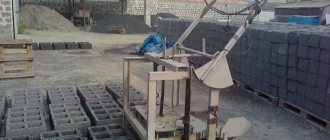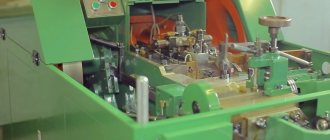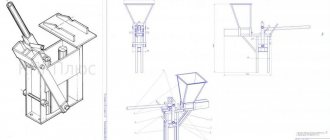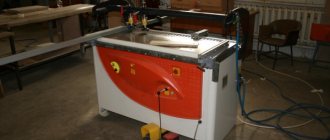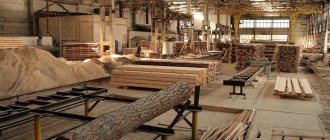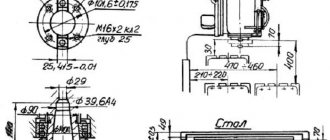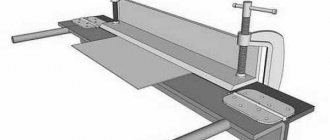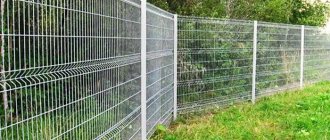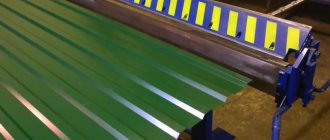Description of the technological process
The machine performs all work on manufacturing products automatically. The operator is required to: load a spool of wire, program the microprocessor according to certain parameters (wire thickness, cell diameter, roll dimensions) and press start.
The wire from the spool, using an unwinding device and guide bushings, is pulled to the area where the spiral is formed, where it is wound onto an auger (a working mechanism that twists the wire into a spiral for subsequent weaving).
The wound spirals move to the guillotining mechanism, where the wire is cut. One of the ends of the wire is bent in the form of a hook (half the length of the intended cell), the workpiece is pulled through the groove of a continuously rotating shaft and attached to a guillotining device.
The cut spiral is held by grippers, stretching under the influence of a suspended load.
Then, the machine winds the next spiral, interweaving the one that is held by the grippers, forming the cells of the chain-link mesh. After cutting the newly formed spiral, the grippers release the held wire and the mesh is wound into a roll of the programmed length.
The mesh is processed with machine oil, the edges are packed in thick paper and the finished rolls are compactly folded into the designated storage space.
Chain-link mesh manufacturing technology
The operating principle of ACP15/2 is simple and consists of several steps. Almost anyone can master:
- load the wire spool into the machine;
- set the microprocessor certain parameters of the future chain-link – wire cross-section, mesh cell diameter, roll dimensions, and press the “start” button;
Then the work of the machine itself begins:
- the unwinding device pulls the wire out of the coil and pulls it to the area where the spiral is formed by guide bushings;
- it is wound onto a special screw, which twists the wire into a spiral for weaving;
- the finished spirals are fed to a trimming device, where they are trimmed;
- one end of the wire is bent in the form of a hook (the size of the bend should not exceed half of the given cell);
- after – the machine winds one spiral onto another, forming cells, and so on until the mesh reaches the specified dimensions. The whole weaving process will become much clearer if you watch the video at the end of the article.
At the final stage, the machine operator starts working again. His responsibilities include treating the finished roll with machine oil to prevent rust, packing the ends of the mesh rolls with thick paper, and storing them in a designated place.
Types of equipment
The equipment used for the production of chain-link differs in the level of mechanization of manual labor. The following types of equipment for mesh production are distinguished:
- hand tools;
- semi-automatic machines;
- automatic installations.
Machines, depending on the degree of automation, differ in price and performance.
Hand tools
A manual machine makes it possible to independently produce a mesh of the required size. The compact, low-noise, inexpensive machine does not require electricity costs, since it runs on human muscle power.
The installation allows you to produce up to 50 meters of chain-link mesh per shift, provided that an experienced craftsman works. The machine is not intended for the production of chain-link on a commercial scale, since it has low productivity and a limited service life. However, a manual plant is quite capable of producing products to meet its own needs.
Among the machines offered on the market, it should be noted:
- Machine for mesh brand BMP, cost from 18,700 rubles;
- Manual machine for chain-link "MODEL SB - 1406", cost from 12,000 rubles.
Semi-automatic device
Working on a semi-automatic machine implies the constant participation of the operator in the production process. However, no special preparation is required. Responsibilities include threading the wire, and upon completion of the production cycle, winding the mesh into rolls. Units of this type have advantages over other models, namely, compact size and light weight of the devices with their high productivity (one machine produces 120-150 p/m of chain-link per shift), efficiency, ease of setup and control, as well as a relatively low price.
The following models are available on the market:
- Semi-automatic reinforced Machines 74, cost from 95,000 rubles;
- Semi-automatic SB - 1407, cost from 62,000 rubles;
- Machine Tools 74, cost from 40,000 rubles.
Automated designs
Automatic machines themselves provide the entire production cycle without operator participation: you just need to program the necessary parameters and load the wire into the machine. This machine guarantees powerful performance, precision weaving and high speed. The productivity of the installations reaches 120 p/m of mesh per hour. Before starting work, the operator must undergo introductory training on how to operate the unit. When purchasing an automatic machine, you should also take into account the potential costs of commissioning, inspection and maintenance of equipment. Installations of this type are aimed at commercial production.
The following automatic installations are noted for their high quality and productivity:
- ASP-6, cost from 359,000 rubles;
- ASU-174M, cost from 155,000 rubles;
- SB - 1408, cost from 215,000 rubles;
- MODUL B-747, price from 335,000 rubles.
Equipment for the production of chain-link mesh
All equipment is a machine for the production of chain-link mesh. Among the variety of types and manufacturers of equipment for making chain-link, it is quite difficult to choose the machine that is most suitable for you, especially if you have a very superficial understanding of its operation.
The two main options worthy of attention are factory-made (there are also hand-made assemblies) machines - semi-automatic or automatic.
Semi-automatic machines for weaving mesh netting
The main disadvantage, which is also some advantage of such a machine, is the participation of the operator in its work. The advantages are continuous control over the production process, small dimensions of the machine, simple setup of equipment, and low price - from 20 thousand rubles (used machines) to 50 thousand rubles (new factory ones).
The disadvantages are that some operations have to be performed manually, including bending the mesh, which can lead to disruption of the cell dimensions and the appearance of other small flaws.
Automatic chain linking machines
An ideal option for those who want to produce high quality products and minimize defects. Maintenance of such a machine comes down to loading a spool of wire into the machine and removing the finished roll of mesh.
The advantages of an automatic machine are its greater productivity - up to 100 sq. meters in one hour, compliance with the specified mesh weaving parameters, minimal human participation. There are also disadvantages - the high price of the equipment - from 200 to 350 thousand rubles, the high cost of repairs in case of breakdown, the need to train personnel to operate the machine.
As an example of the equipment of a workshop, we can cite ACP15/2 - a machine on which the chain-link is produced automatically, the package of which includes:
- the machine itself;
- wire unwinding device;
- 2 sets of equipment, consisting of a screw bushing, a winding plate, and a receiving pipe);
- machine passports and documentation on operating rules.
Such a machine costs around 250 thousand rubles (plus or minus 10-20 thousand). The width of the mesh cells produced on such equipment is from 20 to 60 mm, productivity is from 21 to 62 sq. meters of grid per hour (depending on the size of the grid cells).
Additional equipment for the workshop will consist of:
- racks for storing finished mesh;
- reception desk;
- and the operator's workplace.
Of course, you should not limit yourself to one machine if you have the financial opportunity to purchase several and there are product sales channels.
Similar business ideas:
- how to start a nail production
- how to organize the production of self-tapping screws
- production of paving slabs
Equipment for the production of chain-link mesh and a room for a mini-workshop
The main expense of organizing the production of chain-link is the purchase of machines that produce the mesh. There are many types and manufacturers (on the Internet you can even find instructions on how to assemble a machine yourself from “off-hand” parts). We will not delve into the delights of folk craftsmen, so we will consider two main industrial options: semi-automatic and fully automated machines.
Semi-automatic - require the participation of an operator who controls the mesh manufacturing process. Advantages: small size, ease of setup and operation, low cost (35,000 - 40,000 rubles). The main disadvantage: despite the partial automation of the process, a lot has to be done manually, incl. and bending of the mesh, which allows for a certain asymmetry in cell sizes and other minor imperfections.
Automatic - provide a fully streamlined production process that does not require outside intervention.
Advantages: high productivity, precision weaving, quick bending and minimal operator intervention (load the reel, remove the finished roll).
Disadvantages: higher price compared to semi-automatic (from 200,000 rubles), cost of repair and maintenance, need for special training of personnel.
To calculate the business plan, it is planned to purchase an automatic machine ACP15/2 worth 250,000 rubles. in the following configuration: machine, unwinding device, 2 sets of equipment (screw bushing, winding plate, receiving pipe), passport, operating instructions. The machine produces mesh in accordance with GOST 5336-80 in a wide range of cell sizes (20-60 mm). The cost of equipment includes delivery, personnel training and warranty maintenance for a year.
Additional expenses - the purchase of racks for storing finished products, a receiving table, an operator's workplace costing 50,000 rubles.
Total capital investment for opening a mini-workshop: RUB 300,000.
Before purchasing equipment, you need to select premises for production.
To operate one machine, 15 m2 + 10-15 m2 for storing finished products will be enough. The main requirement for the premises is the presence of a 3-phase electrical network.
Equipment for the production of chain-link mesh - machine
In order to organize your own business producing chain-link mesh, you must first buy all the necessary equipment. These can be either automatic (automatic) or semi-automatic machines.
Video of the production process with a simple machine:
Semi-automatic machines require an operator who monitors the entire production process and is directly involved in it. This device is easy to use, easy to set up, relatively small in size and costs about 40,000 rubles.
Using automatic machines, you can organize production so that all its processes take place automatically without the participation of an operator. But the price for such a machine will fluctuate between 200,000-250,000 rubles.
Video of the machine working:
This machine is quite compact.
Next we will talk about semi-automatic machines, since we will be dealing with low-cost production at first.
The cash costs that go towards purchasing a machine for the production of chain-link mesh will have to be 35,000-40,000 rubles.
Before buying a machine, you need to find a production facility. It could be some kind of warehouse or garage. The area of the selected room should be 10-20 square meters. meters. The premises are used for the production and storage of finished chain-link mesh. In most regions of Russia, monthly rent for such premises will cost several thousand rubles.
Types of machines
Equipment for knitting mesh netting is represented by a large number of machines. They differ in types, and sometimes it is not easy to choose the appropriate option. When choosing, an important condition is the quality of the machines, which will allow you to make a good chain-link. The weaving process should be easy to control and highly technological. Chain-link mesh is made on different types of machines.
Manual option
Suitable for weaving mesh at home. In order for this equipment to work, the constant participation of a worker will be required. This makes the process unprofitable and time-consuming. As a rule, such a machine has a manual drive. Among the differences it is worth noting the small size. For a manual unit, 3 square meters is enough. You have to wind and braid the mesh spirals by hand. Such a machine consists of a strong supporting frame for fastening the working units (bed), a working element responsible for winding the mesh (auger), a drive lever, a gearbox, and guide rollers. Such machines are not used for commercial purposes, since their operation requires the constant presence and intervention of the worker. As a result, the process turns out to be unprofitable from an economic point of view and time consuming.
Using manual installation, you can make spirals from wire with a diameter of 1.5-6 mm. The cell size can vary from 0.3 to 0.6 dm. This parameter depends on different screws. With experience, 50-60 meters of chain-link fabric can be produced in one shift. It is difficult to produce commercial volumes of mesh on such a machine, and the machine has a short service life. Using a manual unit, you can make a sufficient volume of chain-link to create any kind of fencing (for a site, around a house). A large number of units of this type are offered for sale, but among them the BMP brand stands out. Its features are simple design and failure resistance.
Semi-automatic
The semi-automatic machine combines wide functionality and compact dimensions at the same time. This device is suitable for weaving mesh even in the garage. The cost of the unit starts from 45,000-50,000 rubles. Semi-automatic equipment must be operated by a person, since some processes are manual. For example, these include bending the mesh. The disadvantages of the device include inaccuracies associated with the human factor present. Most often, such machines are stationary and are distinguished by significant weight and good performance. It is best to place them on 10 square meters. m, in a place where there is a constant power supply.
Wire feeding and cutting, as well as web weaving are carried out mechanically. The performance level of such devices is sufficient for medium-sized commercial production. Moreover, the quality of the mesh on semi-automatic equipment is better than on a manual device. Using such a unit, you can produce from 120 to 160 linear meters of mesh per shift. There are devices that do not have a control module (PS) and those with a control unit (PS-A). Among the most popular options is PSR-2, which works with wire with a diameter of 0.1-0.3 cm. It produces a mesh with cells of 0.2-0.6 dm. In this case, the width of the canvas will be about two meters.
Machine
The machine is perfect for mass production of high-quality chain-link. When working with such a device, the operator only loads the tray with the source materials and then removes the finished roll. The automatic unit is highly efficient. In an hour he is able to create 100-120 sq. m of chain-link mesh. Such a device can be placed on an area of 15 square meters. m
When using equipment, it is important to ensure that operating modes are performed correctly and that the machine is in good working order. The machine automatically curls spirals, weaves mesh cells, bends the ends and even rolls them into rolls
Wire with a diameter of 0.8-6 mm can be used as raw material. In this case, the cell size can be up to 8 cm, and the web width can be 20-250 cm. Due to a good control system, one employee is enough to control several automatic machines at once. In such installations, all parts are of high quality and reliability. The working life of the units reaches 15-20 km of road surface.
Demand analysis and market assessment of chain-link mesh
According to consumption estimates, about 90% of all manufactured mesh is used for arranging fences and other barriers at construction sites, personal gardens and summer cottages, and making enclosures for birds and animals. The remaining 10% is occupied by various needs of construction, agriculture, mechanical engineering, energy (reinforcement during plastering work, sifting crushed rocks and building materials, strengthening slopes from embankments, manufacturing protective screens for ventilation shafts, protecting heating mains and pipelines, etc.).
The price of the mesh and its use depends on the following factors:
- cell sizes;
- material for manufacturing (ferrous, galvanized metal, polymer coatings, stainless steel);
- wire thickness;
- roll sizes.
Before starting production, you should assess the demand for chain-link mesh in your region: take into account the quantity, approximate sales volumes, assortment (and the most popular items) of competitors, analyze existing offers and prices at wholesale construction sites and retail stores.
The main channels for the sale of chain-link mesh (finished products):
1) Independent implementation. The final consumer is individuals.
Pros: ability to set a maximum markup.
Cons: advertising costs, space for a store or showroom, transportation costs (delivery).
2) Retail stores (construction, hardware). Targeted at summer residents, owners of country houses, private construction. The final consumer is individuals.
Pros: when concluding a sales agreement with a chain of retail stores, you can achieve relatively constant sales of products.
Disadvantages: high store markup (about 30%), high competition, small volumes, sales dependent on many unpredictable factors (recommendations of the seller, location of the product on the shelf, attractive appearance);
3) Wholesale centers (companies selling various metal products). Focused on large orders, construction companies, industrial enterprises, retail chains. The end consumer is legal entities of all forms of ownership, private entrepreneurs.
Pros: large volumes, time saving (no need to go shopping, negotiate, sign agreements, etc.).
Cons: high competition, large but irregular, mostly seasonal sales, which can be described in one phrase: “rarely, but accurately.”
4) Direct sales to industrial enterprises (participation in tenders)
Pros: ability to work “to order”, guaranteed level of sales. Products are not stored in the warehouse, they are paid according to the contract, without vague deadlines for implementation.
Cons: for a “newbie” in business, winning a tender on favorable terms is almost impossible.
Of course, in theory, the best option would be to work out all the channels, but in practice, such a volume of work is impossible to accomplish in a short period of time. Therefore, the general recommendation is to start with retail sales, while simultaneously searching for alternative options and developing your own customer base.
Calculation of a business plan for the production of chain-link mesh
To calculate the profitability of a business, let’s take as a finished product the most popular mesh for fencing with cell dimensions of 55*55 mm, made of galvanized wire 1.6 mm thick.
Revenue part
Machine productivity (for cell size – 55 mm) – 48 m2/hour. With single-shift work and 22 working days per month, production volumes will be: 48 m2 * 8 hours * 22 days = 8448 m2/month.
The standard mesh roll dimensions are 15 m2 (10 m long, 1.5 m wide). That is, the monthly production volume from one machine will be 563 rolls.
Selling price:
- retail – 650 rub./roll (30% of sales),
- wholesale – 450 rub./roll (70% of sales).
Total income: (169 roll * 650 rub.) + (394 * 450) = 287,150 rub./month.
Cost calculation
The raw material for the production of chain-link mesh is low-carbon wire (according to GOST 3282-74) without coating, galvanized or with a colored decorative polymer coating.
The price per ton of galvanized low-carbon wire with a tensile strength of 560-900 N/mm2 and a diameter of 1.6 mm is 37,000 rubles.
Wire consumption per 1 m2 of chain-link mesh is calculated by the formula: Weight (kg) = (13.40 * D2 /A, where 13.40 kg/mm is a constant coefficient; D - wire diameter in mm; A - cell diameter in mm .
According to this formula, the wire consumption for a chain-link mesh with a mesh size of 55 mm will be equal to: (13.40 * 1.6²) / 55 = 0.62 kg.
Cost of a roll (based on the wire spent) = (weight of wire * number of m2 per roll * cost of mesh) = 0.62 kg * 15 m2 * 37 rubles = 344.10 rubles.
Cost of 563 rolls (productivity per month) = 193,728.30 rubles.
Expenditure part
To accurately calculate expenses, from the difference between the profit from sales and the cost of production, you need to subtract the wage fund for hired workers, utilities, electricity, rent and other costs, which are calculated individually, based on tariffs, prices and agreements in each specific situation and for a specific area.
Approximate calculation algorithm:
Salary (1 operator, 1 sales manager) – 32,000 rubles/month,
Salary taxes – 14,400 rubles/month,
Rent of a mini-workshop 30 m2 – 10,000 rubles/month,
Electricity (with machine consumption 1.5 kW/hour) – (1.5 kW/hour * 176 hours) * 4 rubles/hour = 1056 rubles/month,
Other utility bills (heating, garbage removal, water) – 2000 rubles/month.
Income tax (USN) – (287,150.00 – 193,728.30 – 59,456.00) * 15% = 5094.86 rubles/month.
Total expenses: 64,550.86 rubles/month.
Wire for the production of chain-link mesh and its corrosion
In order to master the machine and use it to obtain the first batch of chain-link mesh, you need to purchase wire. 500 kg of mesh costing 17,500 rubles will be enough for you.
The raw material for making mesh netting is low-carbon steel wire. Along with steel wire, polymer-coated and galvanized wire is used. It is extremely rare that a chain-link mesh is made from stainless wire.
Most “coated” chain-link mesh is made from galvanized steel wire. Therefore, the amount of zinc on galvanized wire is very important. Most factories in the CIS countries coat the wire with zinc using the hot-dip galvanizing method. With this method, the zinc content on the wire ranges from 70 to 90 g/m2. A chain-link mesh made from such wire will not rust for 20-25 years. Recently, they have begun to develop wire coating using the electrolytic method. But the wire will contain only 10 g/m2 of zinc, which, in turn, is very little. A mesh made from such wire begins to rust within a year or two after the start of its operation.
However, if the chain-link mesh is used on the coast of the salt sea, then even a large amount of zinc cannot save it from corrosion. In such areas, it is recommended to use a mesh made of steel wire coated with a polymer coating.
Best models
The rating of the machines showed that among all the variety, three models especially stand out.
ACP15/2
In first place is the ACP15/2 machine, characterized by simple settings and controls. He produces chain-link mesh in small quantities. Due to the low noise level, any location is suitable for installation, even near residential buildings. Without an operator, the unit is capable of independently bending the ends of the mesh, winding the fabric, cutting and stopping. As for all other processes, they are performed by humans. At the exit from the machine, a mesh with a cell of 18-50 mm and a height of 2-3 meters is obtained. For knitting, wire in one thread is used. Moreover, it may have a polymer coating or be unevenly rigid.
The advantages of the device include a gearmotor as a single unit, as well as an improved cooling system due to an emulsion pump. The guide bushings serve for a very long time and without failures, as they are coated with special hard alloys. If the unit is forced to stop, the program settings that were previously set are not lost.
SPA 01-04
Second place went to a knitting machine called SPA 01-04. This machine creates a mesh with a cell size of 2-6 cm. Conveniently, the starting material is one millimeter thick galvanized wire. The unit works completely independently. The operator only prepares the work template in advance, and also supplies the starting materials and removes the finished materials from the unit.
The device automatically unwinds the wire, weaves a chain-link, bending the ends on each of the cells. At the end of weaving, the finished fabric is rolled into a roll. If the material becomes entangled at one of the stages of the device’s operation, it will stop automatically. Conveniently, the unit is equipped with high-quality cooling to avoid overheating. In an hour the device is capable of producing 65-180 sq. meters of chain-link. If desired, the machine can be supplemented with special devices that allow you to wind the mesh on a separate reel. It is convenient that the unit can bend the ends of the chain-link on both sides.
VSA-97
The top best machines for weaving chain-link also included the VSA-97 model. Using this device, you can obtain a web with a cell of 10-60 mm and a width of 50-200 cm. Among the advantages of the unit, users note the universal design of the pass elements, which allows the use of any wire. The machine can be repaired using simple automotive parts. You can find the latter in any specialized store, which can be found even in small towns.
To install the machine you will need approximately 20 square meters of area. One operator will be able to work simultaneously with three such devices. Productivity is directly affected by the quality of the wire. For example, with stable feedstock, the machine can produce 50 square meters per hour. m of canvas with a cell of 50 mm. Many people also like that the device is easy to set up and performs all functions automatically.
Semi-automatic machines
Such machines for the production of chain-link mesh are stationary; they have large weight, dimensions and productivity.
To place them you will need at least 10 square meters and a constant power supply. The main working parts of this device are the same as those of a manual one. The following operations are mechanized:
- wire feed;
- wire cutting;
- weave of mesh fabric.
The operator threads the wire and engages the spirals during weaving. The operator also has to roll the fabric into rolls.
Semi-automatic machine
Such equipment provides sufficient throughput to make commercial mesh production worthwhile on a small to medium scale. Due to the constant bending force and scrolling speed, the quality of the final product is significantly higher than with manual production. One machine is capable of producing 120-150 linear meters of chain-link per shift.
Among the models on sale, the PSR-2 machine stands out. It is capable of working with wire from 1 to 3 millimeters and forms cells from 2 to 6 centimeters. The width of the produced canvas is up to 2 meters. A durable welded frame made of metal profile provides good support and does not require additional fastening to the floor.
Calculation of income and expenses
Average values are given here, so in your case the numbers may differ either up or down.
Raw materials
We calculate the costs that go into the production of one roll of chain-link mesh. One ton of wire costs about 35,000 rubles. The weight of a roll of chain-link mesh made of wire with a diameter of 1.6 mm and a cell size of 55 mm will be approximately 9.5 kg. The cost of such a roll, taking into account the amount of wire used, is 333 rubles.
Workers' wages
As a rule, the salary of employees in big cities is higher than in small towns, and it is even lower in villages. We will consider the salary of a machine operator using the example of Stary Oskol. Let it be 16,000 rubles in 22 working days. Let's take into account that it is better to pay wages depending on the number of mesh rolls produced. During one shift, 11 rolls are produced or 22 rolls per day. Then the production of one roll should cost 70 rubles.
Electricity costs
The price of 1 kW/h is approximately 4 rubles. The energy consumed by the machine for making mesh netting is 1.5 kW/h. But in addition to producing the mesh, the rolls are also packaged and loaded onto racks. This means that in 1 hour a little less than 1.5 kW/h will be spent. Then we will assume that 1 kW/h of energy is spent to produce one roll of chain-link mesh.
Renting premises
We calculate the rent for the premises as a share of one produced roll of chain-link mesh. 22 rolls will be produced in one day. For 22 working days (for 1 month) – 484 rolls. As a result, we receive an amount of 2-4 rubles.
Additional costs for taxes, transportation, etc. will be 10-20 rubles per roll.
Total cost
For one roll of mesh, a chain-link made of 1.6 mm wire and a mesh size of 55 mm, the cost will be as follows:
Wire price (333 rubles) + worker's payment (70 rubles) + electricity costs (4 rubles) + rental fee (2-4 rubles) + additional expenses (10-20 rubles) = 419-431 rubles .
Profitability of production
Having calculated the cost of production of one roll of chain-link mesh, we will calculate the income per roll of mesh. To do this, you need to find out the cost at which the manufactured mesh will be sold. In turn, for this you need to study the prices of competitors' products.
The wholesale price for a chain-link mesh with a mesh size of 55 mm and made of wire 1.6 mm thick is about 600 rubles per roll. The profit should be:
- 600 – 419 = 181 rub.
- ...or 600 – 431 = 169 rubles.
Calculations were made taking into account the fact that the average retail price for chain-link mesh in Russia is about 1000 rubles.
To calculate the monthly profit, you need to multiply the obtained values by the number of rolls that are produced in one month. In our case, it is equal to 484. Then the monthly profit should be 87604-81796 rubles.
According to the calculations received, we conclude that the costs that we have at the initial stage will be recouped in just one month. In addition, you can organize the sale of chain-link mesh at a higher price - at retail.
Choosing an organizational form and other legal issues
To open a mini-workshop, the optimal organizational form is an individual entrepreneur (IP). OKVED 28.73 – “Production of wire products.” But the choice of taxation system depends on your target audience of buyers. If the end consumer is private individuals, it will be most beneficial to choose a simplified taxation system. Enterprises prefer to cooperate with legal entities or individual entrepreneurs who pay VAT.
For the business plan, we will take into account taxation according to the simplified tax system – 15%. The tax base is income minus expenses (of course, all financial transactions for calculating taxes must be documented and correctly executed).
The production of chain-link mesh is regulated by GOST 5336-80. According to current legislation, manufacturers are not required to confirm the quality of their products with an appropriate certificate. But in practice, passing voluntary certification and complying with GOST requirements during production significantly increases the chances of running a successful business.
